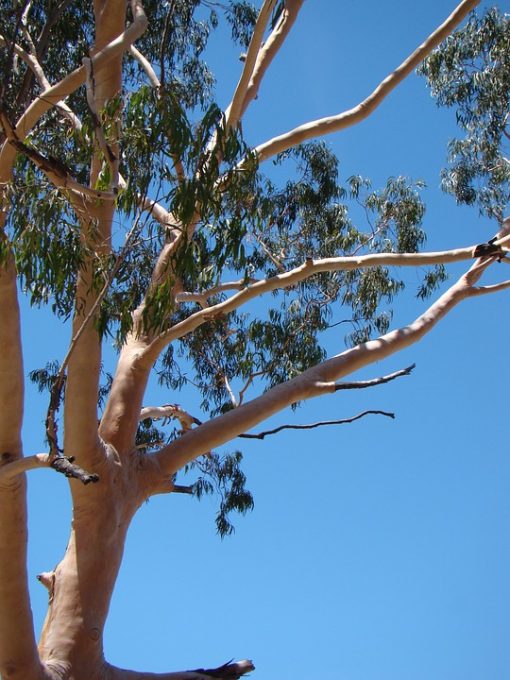

At the April Peer Evening, Dr Greg Moore gave a second talk on the evolution of plants. He explained how understanding the evolution of plants could help us make better choices under climate change and gave examples of how different Australian trees cope with drier conditions. Megan Hallowes reports
Eucalypts are magnificent, but these iconic large Australian trees are poorly understood by our citizens, Dr Greg Moore told a meeting of Sustainable Gardening Australia in April.
The world-renowned authority on Australian trees said a Melbourne city council had passed a resolution banning the planting of Eucalypts on nature strips because local residents were complaining about shedding of leaves, flowers and occasionally branches.
“Do Eucalypts do that? Of course they do. What can you do about it? Nothing. What should you do about it? Nothing. That’s what Eucalypts do,” he said.
He said many plants in the Myrtaceae family, which includes Eucalypts, Callistemon and Melaleuca, have a different approach to canopy development.
“They have what’s called a dynamic crown…. So, with an oak, it gets to a certain size and then gradually gets bigger and bigger and bigger. A Eucalypt grows like the clappers, puts a bit out, it dies back, another bit grows, it dies back, another bit, another bit It’s a dynamic crown and each time something dies, it sheds and another takes its place. So, do Eucalypts always have dead wood in them? Yes. Are they always shedding bits and pieces? Yes. Is that a sign of an unhealthy Eucalypt? No. That’s just the way they are,” he said.
He said most Australians didn’t realise that there were 700 different species of Eucalypt.
“There are so many of them – tall, short, flowers, not, foliage, blue, green – you can get whatever you want. Multi-stemmed, single-stemmed, in alkaline soil, acid soil … you can virtually write your order,” he said.
Another misunderstanding about Eucalypts is that they are not necessarily waterwise.
They are sclerophyllous plants which means they have tough leathery leaves. Many other Myrtaceae, all the Proteaceae and the Acacias share this characteristic.
“And people have assumed, for centuries in fact, that sclerophyllous flora are adapted to arid conditions, but that’s only partly true. The Australian sclerophyllous flora is adapted to poor nutrients and low rainfall. People think that because they have tough leathery leaves, they will use less water…not necessarily so.
“The fact that they’ve got tough leathery leaves allows these plants to keep their stoma open during the day. And, if their stoma are open, what are they doing? They’re photosynthesizing and if they are photosynthesizing, they’re growing and outcompeting and that’s what we want. But, what are they also doing? They are using water. They are in fact water spendthrifts. That’s not what you want. It’s not what you think you’re getting.”
But, he said, the use of species with high tolerances of low rainfall comes at a cost.
“Now, you may be prepared to pay the cost. We may as a society be prepared to pay the cost. To give you an idea – trees like Casuarina littoralis, Eucalyptus calophylla, the Eremophilas, Pittosporums, Myoporums – they have good stomatal control and efficient water use but if water is limiting, one of the things they do is they slow their growth rate. How will that go down with your customers, how will that go down with the general public, the local councils wanting to establish landscapes quickly? Doesn’t go down well at all.”
Some other trees thin their canopies in response to dry conditions.
To get the kind of vegetation we want in our cities – thick canopies and dense foliage – the answer is to irrigate if you need to and try and use recycled water.
He also said it was important to find out how different species would behave under our urban environments, our nutrient-deficient soil and irrigation systems.
“There are many native species that do actually do all the things we want – conserve water, grow well, but you have to be discerning and you have to know what you’re going after.”
Dr Moore said it was also important for Australians to know something about the evolution of our flora. For example, Australia has a bigger range and far more diversity of flowering plants than the northern hemisphere because these plants evolved in the south.
He said that Angiosperms (flowering plants) evolved from a group of plants called Glossopterids about 100 million years ago on the southern landmasses.
It used to be thought that Australian flora was imported from elsewhere, but “there was an absolute revolution in the way we viewed the Australian flora through the late 70s into the mid-1980s which basically said, hey, hey our flora is uniquely ours, it’s been here for 100s of millions of years if you follow its evolutionary route and it goes back all the way to the Glossopterids, it goes back all the way to the seed ferns and so our flora has its origins in this part of the world on this tectonic plate going back close to 300 million years.”
“That’s an amazing turnaround in the way you view your flora, the way you view your plant communities and ultimately the way you view the natural communities of our continent.”
Dr Moore said people might be wondering what the point was of talking about things that happened millions of years ago.
“Something that happened 250 million years ago leaves its mark, leaves its heritage on the planet today. And, what happened all that long ago is impacting on our flora in Australia, how our flora evolved and how it is evolving and the impacts will be felt, all being well, way into the future.”
He said “evolutionary stuff” gave us a glimpse of why things are the way they are and a glimpse of where things might go in the future, for example, under climate change.
He said many elements of our Australian flora would cope well with our soils, higher temperatures and lower rainfall.
They’ve been coping with these conditions over the whole of their evolutionary history, after all.

